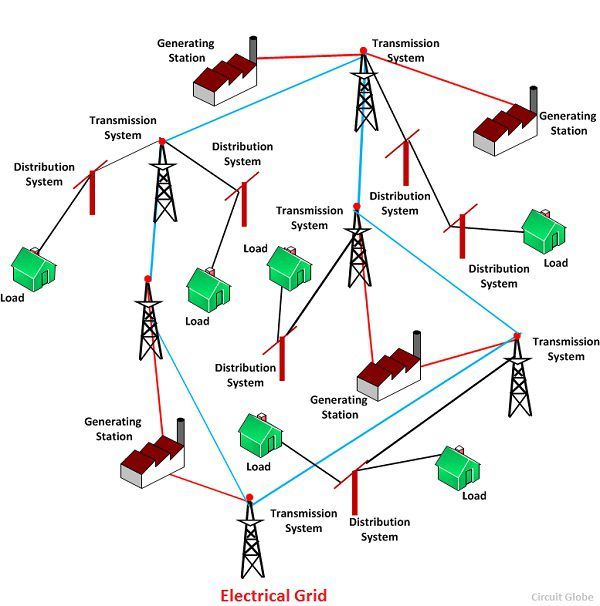Definition: Electrical grid or power grid is defined as the network which interconnects the generation, transmission and distribution unit. It supplies the electrical power from generating unit to the distribution unit. A large amount of power is transmitted from the generating station to load centre at 220kV or higher. The network form by these high voltage lines is called the super grid. The super grid feeds the sub-transmission network operating at 132kV or less.
Types of Electrical Grid
The power station of the grid is located near the fuel source which reduces the transportation cost of the system. But it is located far away from the populated areas. The power which is generated at high voltage is stepped down by the help of step down transformer in the substation and then supply to the consumers.The electrical grid is mainly classified into two types. They are
- Regional Grid – The Regional grid is formed by interconnecting the different transmission system of a particular area through the transmission line.
- National Grid – It is formed by interconnecting the different regional grid.
Reason for an Interconnection
The interconnection of the grid provides the best use of power resource and ensures great security to supply. It makes the system economical and reliable. The generating stations are interconnected for reducing the reserve generation capacity in each area.
 If there is a sudden increase in load or loss of generation in a zone, then it borrows from the adjacent interconnected area. But for the interconnections of the network certain amount of generating capacity known as the spinning reserve is required. The spinning reserve consists generator running at normal speed and ready to supply power instantaneously.
If there is a sudden increase in load or loss of generation in a zone, then it borrows from the adjacent interconnected area. But for the interconnections of the network certain amount of generating capacity known as the spinning reserve is required. The spinning reserve consists generator running at normal speed and ready to supply power instantaneously.
Types of an Interconnections
The interconnection between network is mainly classified into two types, i.e., the HVAC link and HVDC link.
HVAC (High Voltage Alternating Current) Interconnection
In HVAC link the two AC systems are interconnected by an AC link. For interconnecting the AC system, it is necessary that there should be sufficiently close frequency control on each of the two systems.
For the 50Hz system, the frequency should lie between 48.5 Hz and 51.5 Hz. Such an interconnection is known as synchronous interconnection or synchronous tie. The AC link provides a rigid connection between two AC system to be interconnected. But the AC interconnection has certain limitations.
The interconnection of an AC system has suffered from the following problems.
- The interconnection of the two AC networks is the synchronous tie. The frequency disturbances in one system are transferred to the other system.
- The power swings in one system affect the other system. Large power swing in one system may result in frequent tripping due to which major fault occurs in the system. This fault causes complete failure of the whole interconnected system.
- There is an increase in the fault level if an existing AC system is connected with the other AC system with an AC tie line. This is because the additional parallel line reduces the equivalent reactance of the interconnected system. If the two AC system are connected to the fault line, then the fault level of an each AC system remains unchanged.
HVDC (High Voltage Direct Current) Interconnection
The DC interconnection or DC tie provides a loose coupling between the two AC system to be interconnected. The DC tie between two AC systems is non-synchronous (Asynchronous). The DC interconnection has the certain advantages. They are as follows.
- The DC interconnection system is asynchronous thus the system which is to be interconnected is either of the same frequency or at the difference frequency. The DC link thus provides the advantages of interconnection of two AC network at different frequencies. It also enables the system to operate independently and to maintain their frequency standards.
- The HVDC links provide fast and reliable control of magnitude and direction of power flow by controlling the firing angle of converters. The rapid control of power flow increases the limit of transient stability.
- The power swings in the interconnected AC networks can be damped rapidly by modulating the power flow through the DC tie. Thus, the stability of the system is increased.
Nowadays, the customary grids are replaced by the smart grids. The smart grid uses the smart meter and appliances which improves the efficiency of the system.

Very nice
Nice
Wow it’s very satisfying info & understanding
Thank you, clear and simple. It will help me